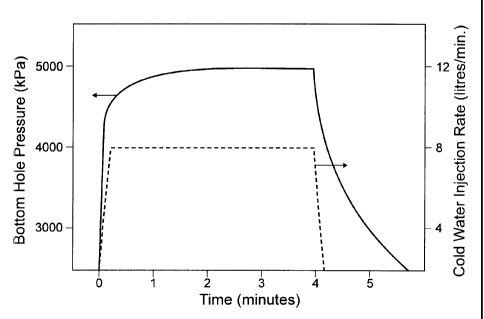Some of the information on this Web page has been provided by external sources. The Government of Canada is not responsible for the accuracy, reliability or currency of the information supplied by external sources. Users wishing to rely upon this information should consult directly with the source of the information. Content provided by external sources is not subject to official languages, privacy and accessibility requirements.
Any discrepancies in the text and image of the Claims and Abstract are due to differing posting times. Text of the Claims and Abstract are posted:
| (12) Patent: | (11) CA 2358555 |
|---|---|
| (54) English Title: | STEAM INJECTION PRESSURE IN A STEAM-ASSISTED GRAVITY DRAINAGE PROCESS |
| (54) French Title: | PRESSION D'INJECTION DE VAPEUR POUR PROCEDE DE DRAINAGE GRAVITAIRE PAR INJECTION DE VAPEUR |
| Status: | Expired |
| (51) International Patent Classification (IPC): |
|
|---|---|
| (72) Inventors : |
|
| (73) Owners : |
|
| (71) Applicants : |
|
| (74) Agent: | JOHNSON, ERNEST PETER |
| (74) Associate agent: | PARLEE MCLAWS LLP |
| (45) Issued: | 2006-07-25 |
| (22) Filed Date: | 2001-10-04 |
| (41) Open to Public Inspection: | 2003-04-04 |
| Examination requested: | 2001-10-04 |
| Availability of licence: | N/A |
| (25) Language of filing: | English |
| Patent Cooperation Treaty (PCT): | No |
|---|
| (30) Application Priority Data: | None |
|---|
The pressure at which cold water is initially injectable into an oil sand formation is determined. In the practice of steam-assisted gravity drainage in that formation, steam is injected at a pressure greater than the cold water initial injectivity pressure but no more than 1500 kPa grater than that pressure.
La pression à laquelle l'eau froide est initialement injectable dans une formation de sable pétrolifère est déterminée. Dans la pratique de vapeur pour procédé de drainage gravitaire dans cette formation, on injecte de la vapeur à une pression supérieure à la pression de l'injectivité initiale de l'eau froide, mais sans excéder 1500 kPa de plus que cette pression.
Note: Claims are shown in the official language in which they were submitted.
Note: Descriptions are shown in the official language in which they were submitted.

For a clearer understanding of the status of the application/patent presented on this page, the site Disclaimer , as well as the definitions for Patent , Administrative Status , Maintenance Fee and Payment History should be consulted.
| Title | Date |
|---|---|
| Forecasted Issue Date | 2006-07-25 |
| (22) Filed | 2001-10-04 |
| Examination Requested | 2001-10-04 |
| (41) Open to Public Inspection | 2003-04-04 |
| (45) Issued | 2006-07-25 |
| Expired | 2021-10-04 |
There is no abandonment history.
| Fee Type | Anniversary Year | Due Date | Amount Paid | Paid Date |
|---|---|---|---|---|
| Request for Examination | $200.00 | 2001-10-04 | ||
| Application Fee | $150.00 | 2001-10-04 | ||
| Registration of a document - section 124 | $100.00 | 2003-07-18 | ||
| Maintenance Fee - Application - New Act | 2 | 2003-10-06 | $100.00 | 2003-10-02 |
| Maintenance Fee - Application - New Act | 3 | 2004-10-04 | $100.00 | 2004-10-01 |
| Maintenance Fee - Application - New Act | 4 | 2005-10-04 | $100.00 | 2005-09-15 |
| Final Fee | $300.00 | 2006-04-26 | ||
| Maintenance Fee - Patent - New Act | 5 | 2006-10-04 | $200.00 | 2006-09-07 |
| Expired 2019 - Corrective payment/Section 78.6 | $350.00 | 2006-10-03 | ||
| Maintenance Fee - Patent - New Act | 6 | 2007-10-04 | $200.00 | 2007-09-17 |
| Maintenance Fee - Patent - New Act | 7 | 2008-10-06 | $200.00 | 2008-09-25 |
| Maintenance Fee - Patent - New Act | 8 | 2009-10-05 | $200.00 | 2009-09-01 |
| Maintenance Fee - Patent - New Act | 9 | 2010-10-04 | $200.00 | 2010-08-23 |
| Maintenance Fee - Patent - New Act | 10 | 2011-10-04 | $250.00 | 2011-09-29 |
| Maintenance Fee - Patent - New Act | 11 | 2012-10-04 | $250.00 | 2012-09-24 |
| Maintenance Fee - Patent - New Act | 12 | 2013-10-04 | $250.00 | 2013-09-26 |
| Maintenance Fee - Patent - New Act | 13 | 2014-10-06 | $250.00 | 2014-09-17 |
| Maintenance Fee - Patent - New Act | 14 | 2015-10-05 | $250.00 | 2015-09-17 |
| Maintenance Fee - Patent - New Act | 15 | 2016-10-04 | $450.00 | 2016-09-19 |
| Maintenance Fee - Patent - New Act | 16 | 2017-10-04 | $450.00 | 2017-08-31 |
| Maintenance Fee - Patent - New Act | 17 | 2018-10-04 | $450.00 | 2018-09-12 |
| Maintenance Fee - Patent - New Act | 18 | 2019-10-04 | $450.00 | 2019-09-23 |
| Maintenance Fee - Patent - New Act | 19 | 2020-10-05 | $450.00 | 2020-09-17 |
Note: Records showing the ownership history in alphabetical order.
| Current Owners on Record |
|---|
| JAPAN CANADA OIL SANDS LIMITED |
| Past Owners on Record |
|---|
| ITO, YOSHIAKI |